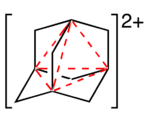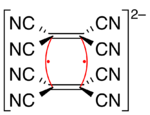

A4-center 2-electron (4c–2e) bond is a type of chemical bond in which four atoms share two electrons in bonding, with a net bond order of 1⁄2. This type of bonding differs from the usual covalent bond, which involves two atoms sharing two electrons (2c–2e bonding).
Four-center two-electron bonding is postulated in certain cluster compounds. For instance, the borane B
6H−
7 anion, is a B
6H2−
6 octahedron with an additional proton attached to one of the triangular faces.[1] As a result, the octahedron is distorted and a B–B–B–H rhomboid ring can be identified in which this 4c–2e bonding takes place. This type of bonding is associated with electron deficient rhomboid rings in general[2] and is a relatively new research field, fitting in with the already well established three-center two-electron bond.

An example of a purely organic compound with four-center two-electron bonding is the adamantyl dication.[3] The bond joins the four bridgehead atoms in a tetrahedral geometry.

Tetracyanoethylene forms a dianionic dimer in which the two alkenes are joined face-to-face by a rectangular four-center two-electron bond.[4] Various solid salts of this dianion have been studied to determine bond strengths and vibrational spectroscopic details.[5]
|
| ||||||||
|---|---|---|---|---|---|---|---|---|
| Intramolecular (strong) |
| |||||||
| Intermolecular (weak) |
| |||||||
| Bond cleavage |
| |||||||
| Electron counting rules |
| |||||||